|

by Clifford E Carnicom
September 27, 2009
from
Carnicom Website
I am not offering any medical advice or
diagnosis with the presentation of this information. I am acting
solely as an independent researcher providing the results of
extended observation and analysis of unusual biological conditions
that are evident.
SUMMARY
STATEMENT
A partial summary of the research accumulated though this site on
the so-called "Morgellons" issue is as follows:
-
The internal filament repeatedly
described, as in the dental extraction samples, appears to
be a primary pathogenic form. These internal biological
filaments have been identified, to a varying degree, in
essentially all individuals that have participated in the
testing process thus far.
The blood of participating
individuals also displays, to a high correspondence,
anomalies in structural integrity. A sub-micron spherical
structure, to be assessed in further detail at a later
point, also commonly occurs within the erythrocytes.
-
The morphology, size, structure
and chemistry of these internal filaments appears to be
highly similar to that of certain environmental filament
samples, notably that which has been refused by the
Environmental Protection Agency (EPA) for identification.
In addition, numerous research
papers over the last ten years document the repeated
detection of unusual biological components within a series
of environmental samples, including that of erythrocytic
(red blood cell) forms.
-
Numerous cultures have been
developed from the internal filaments on agar and in wine
based mediums. These cultures are essentially identical in
form and chemistry with that of the original internal
biological filament samples.
-
The cultures produced from the
internal biological filaments (dental samples) have been
shown to produce an erythocytic form. These cultures have
produced a positive result for the existence of hemoglobin
by two separate forensic level tests. The determination of
the erythrocytic form is also repeatedly evidenced by direct
observation, measurement and biconcave morphology.
-
The production of erythrotic
forms within direct biological filament samples and by
culture is completely outside the known boundaries of
conventional science and biology. It is repeatedly evident
that these same erythrocytic forms can withstand (and even
flourish in) extremely adverse environmental, chemical and
thermal conditions.
The evidence thus far indicates
the original erythrocytic form is dessicated or spore-like
and a reconstitution process is required to bring the
cellular structures to full form and activity.
-
A method has been developed to
break down the outer casing of the internal biological
dental filaments. The internal components of these
filamaments have been examined in detail upon repeated
occasions.
Two main structures emerge: an
erythrocytic form and a sub-micron spherical form. The best
current assessment of the sub-micron spherical form is that
of being Chlamydia-like, with a special interest in
Chlamydia Pneuomonia. Mycoplasma forms are also strong
candidates of consideration as a "tertiary form" that is
also frequently observed.
Please also refer to the the
paper entitled
Pathogens and the General Population,
April 2008, for the introduction of the Chlamydia-like
structure as a primary topic of interest; the rationale of
identification for this candidate remains. In addition,
recent size measurements and the response of the
Chlamydia-like structure to Giemsa stain further solidifies
that rationale.
-
There is a strong consideration
that the internal structures from the internal biological
filaments are of a synthetic or artificial nature. This
assessment is based upon an observed unifomity in geometry
as well as the hostile chemical environment under which
reconstitution takes place.
-
The internal biological
filaments and the cultured form of the filaments has been
subjected to the same chemical and thermal breakdown
process. The same two internal sturctures are evident and
observed in each case, that of an erthyocytic form and a
Chlamydia-like form.
-
The existence of the internal
biological filaments, the existence of introduced or
modified erthrocytic forms, the Chlamydia-like strructure
and the tertiary form are interpreted by this researcher to
be critical and central aspects of the " Morgellons"
condition.
It is accepted that numerous
symptom manifestations are reported in association with the
condition; this report simply enumerates that which exists
as a common denominator within all studies conducted thus
far.
-
The source of the erythrocytic
forms and the Chlamyidia-like organism is the filament under
study, either in the direct biological internal form or
identically from the cultured source. This assessment is
reached through direct observation.
-
Success has been achieved in
developing a solution based culture that originates from the
decomposition (chemical and thermal) of the cultured
filaments. An aqueous or solution based culture development
has numerous advantages in the development and application
of experimental procedures.
This culture work is based upon the following sequence:
-
Original filament form (biological or cultured)
-
Decomposition of the filament through chemical and
thermal processes
-
A single drop of the resultingsolutionis sufficient to
reproduce the entire cycle
-
The decomposed filament solution is cultured in a wine
medium
-
Two structures appear simultaneously over a period of
several days within the solution when observed under the
micrsocope: The Chlamydia-like form and the pleomorophic
form (Mycloplasma candidate). Visually this material has
an appearance similar to that of the original dental
filament extractions
-
Lastly, the original filament form (white in color)
appears on the surface of the solution, completing the
full cycle of development and growth.
-
The recent solution-based
culture work infers that four varying components comprise
the basic pathogenic form:
-
The encasing filament which
appears to serve for the purpose of housing, transport
and delivery of the internal components
-
An ethryrocytic form
(primarily internal to the filament)
-
A Chlamydia-like structure (
primarily internal to the filament)
-
An apparent pleomorphic form
(primarily internal to the filament). The strongest
candidate of identification at this time is a Mycoplasma
variant
-
All items listed require
positive analytic, chemical and biological testing and
identification; candidate identification is dependent
upon resources available at this time. The ability of
the structures to withstand hostile and adverse chemical
and environmental conditions strongly indicates
modification to originating organisms or structures
-
It can now be shown directly by
observation that the cultured filaments, after decomposition
through chemical and thermal processes, appear to be the
source of the blood anomalies first reported on by this
researcher in November and December 2007. It is anticipated
that the direct biological form of the filaments is likely
to produce an identical result, as the cultured forms derive
from the direct biological forms.
Please also refer to the papers
entitled
Blood Testing and
Morgellons - Airborne, Skin and
Blood - A Match, for a partial background preparation on this
subject. Three structures are observed in the process : erythrocytic, Chamydia-like, and a "pleomorphic (many form)
ribbon or sausage-like form as shown in these original
papers.
A mycoplasma form is a viable
candiate for the "pleomorphic" (tertiary) form.
-
There are now strong parallels
of interest (specifically Chlamyida Pneumonia and Mycoplasma)
that have emerged between the current work and that of
prominent research on the so-called "Gulf War Syndrome".
-
Future immediate needs include a
full protein and genetic analysis of the filament forms,
cultures and components that have been repeatedly
identified. Additional resources will be required to
accomplish this.
-
Growth inhibition studies,
especially upon the culture forms that have been developed,
also exist as an immediate requirement. Preliminary studies
with prospect are in progress. Additional resources can
accelerate this process.
-
The available information
indicates that the human condition is likely to have been
affected en masse.
Additional
Notes to be Incorporated
A match has been made between the internal structures of a
filamentous dental sample and the internal structures from a culture
developed from this same filamentous dental material.
The two samples, one from a direct
biological sample and the other from a cultured medium, also behave
identically under the same chemical conditions. The primary
structure is again of erythrocytic (red blood cell) form. A
secondary structure is again of sub-micron spherical shape, and it
occurs commonly within the erythrocytic form.
Under the observational history and
analysis that has been completed thus far, it is reasonable to
characterize the secondary (sub-micron) structure as Chlamydia-like
in nature (with a particular focus on Chlamydia Pneumonia). This
paper should be studied in conjunction with all recent biological
reports to recognize the uniformity of the findings related to the
so-called "Morgellons" condition.
It is understood that there are likely many numerous variations of
development, form and manifestation with respect to the " Morgellons"
condition. This researcher has focused on, and continues to focus
on, those elements that appear to exist as a common denominator in
most (or all) subjects, regardless of any external symptoms that may
or may not be present.
It remains the assessment of this
researcher that the blood (and the alteration of it) and the
existence of certain filament forms (INTERNAL to the body) are
central to the condition. The existence of skin anomalies does not
appear to be, in any way, a suitable criteria for establishing or
denying the existence of the condition.
Thus far, essentially any individual
that has been studied displays, to a varying degree, the common
denominators of blood anomalies and filament existence that are a
basis of this report.
Exceptions to this last statement in
some fashion are presumed to exist (although not identified thus
far) and they are an obvious desirable pursuit in the research.
Some of the primary functions of the blood include:
-
Transports
-
Dissolved gases (e.g.
oxygen, carbon dioxide)
-
Waste products of metabolism
(e.g. water, urea)
-
Hormones
-
Enzymes
-
Nutrients (such as glucose,
amino acids, micro-nutrients (vitamins &
minerals),
fatty acids, glycerol)
-
Plasma proteins (associated
with defence, such as blood-clotting and anti-bodies)
-
Blood cells (incl. white
blood cells 'leucocytes', and red blood cells
'erythrocytes')
-
Maintains Body Temperature
-
Controls pH
The pH of blood must remain in the range 6.8 to 7.4,
otherwise it begins to damage cells.
-
Removes toxins from the body
The kidneys filter all of the blood in the body (approx. 8
pints), 36 times every 24 hours. Toxins removed from the
blood by the kidneys leave the body in the urine. (Toxins
also leave the body in the form of sweat.)
-
Regulation of Body Fluid
Electrolytes
Excess salt is removed from the body in urine, which may
contain around 10g salt per day
(such as in the cases of people on western diets containing
more salt than the body requires)
Source:
Structures and Functions of the Blood.
Additional
Photographs to be Detailed
|
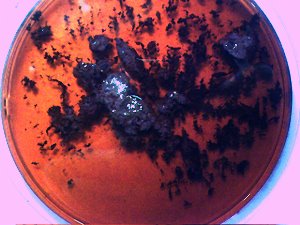 |
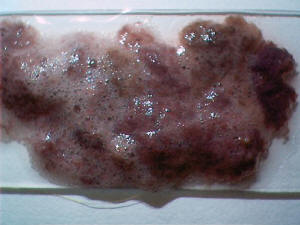 |
|
Original
previously analyzed dental sample material in wine base.
Essentially all individuals tested thus far produce
varying degrees of this dental filament material. |
Representative dental sample material, previously
analyzed, placed onto a glass slide. This particular
sample uses a wine-hydrogen peroxide base mix.
|
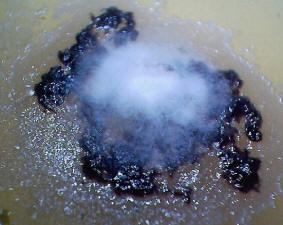
The
culture of the dental filaments at the early stage. Characterized by
a pure white color.
Microscopic and
time lapse imagery of this development are available in more detail
in the papers entitled
Culture
Breakthrough (?), (Jul 2008)
Culture Work is Confirmed (Aug
2008)
Morgellons - Growth Captured (Aug 2008).
|
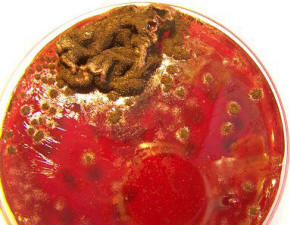 |
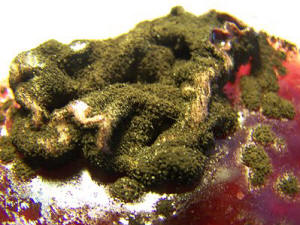 |
|
This is the
culture material used in this test. |
To be
continued. |
|
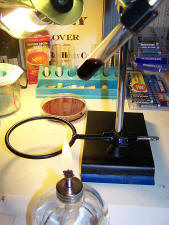
To be
continued. |
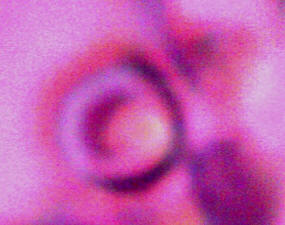
To be
continued. |
|
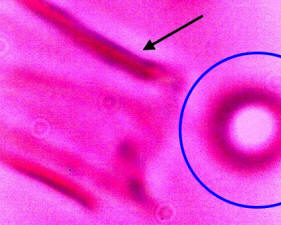
To be
continued. |
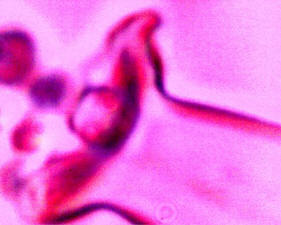
To be
continued. |
|
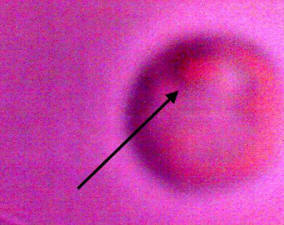
To be
continued. |
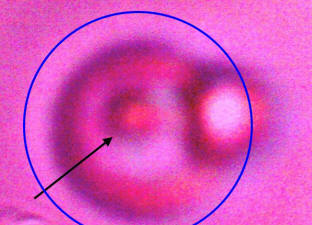
To be
continued. |
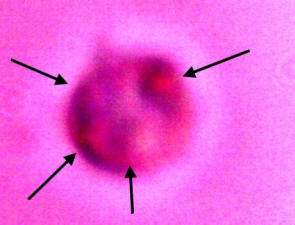
To be
continued. |
|
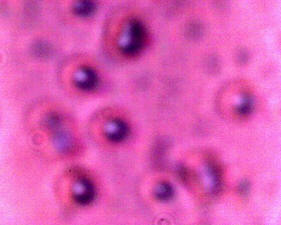
To be
continued. |
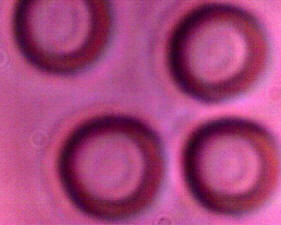
To be
continued. |
|
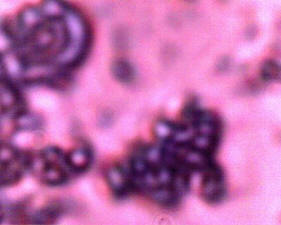
To be
continued. |
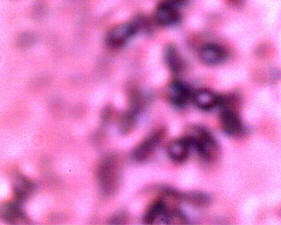
To be
continued. |
|
















